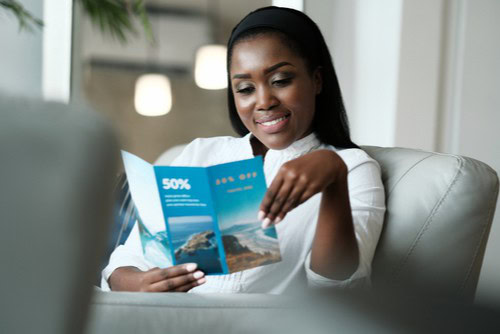Designing a brochure may seem easy, but creating one that captures the attention of your target audience and compels them to keep it for future reference is not as simple as it seems. There are many aspects to consider in brochure design, such as ensuring you are accurately and clearly displaying your products or services, that the content has a good flow to it, and that the information is useful to your reader. While the experienced team at Midwest Marketing is here to take care of all your brochure design needs, we’re also here to let you in on what elements make a brochure effective so you can ensure you’re on the path to success.
Here are seven things to consider before starting your brochure:
1. What will the brochure be used for?
Considering your customer’s needs before creating any marketing piece is essential, and it should be the first thing you think about when planning a brochure. What is the brochure marketing and who is the target audience? Will the brochure be handed out, be placed in racks, or be a direct mail piece? Will the brochure be used one-time, or is it something that the customer will use again and again, such as a take-out menu? These are just a few of the questions to ask to better understand your customer’s needs so you know where to start.
2. What size and folds will be used?
Brochures come in a large variety of sizes and have many different variations in folds. The folds control how the information is presented to the reader, so it’s important to choose the correct fold for your content that your reader will be able to easily follow.
3. How much copy do you need?
Knowing how much content to include can be tricky – too much content can overwhelm, while not enough won’t accurately get your message across. The important thing is to keep the information clear and concise, with just enough content to get your point across. Proofread, proofread, and proofread again for spelling and grammatical errors.
4. What font to use?
Making sure your copy has visual appeal is important as well. Use clean, easy-to-read fonts, and choose no more than two or three fonts for your brochure. Copy for most brochures usually contains a headline, subheading, and the body text, so choosing a font for each is a good way to go.
5. What is the call-to-action?
The call-to-action is the most crucial part of your brochure. This is where you lead your reader to take an intended action, whether it’s to visit your location, head to your website, or call for an appointment. The call-to-action should use a large, bold font to attract the reader’s attention, and be clear as to what you want them to do.
6. What images should be used?
The #1 rule for image use in brochures? Never use low resolution images! A fuzzy logo or photo will take away from the brochure design and make your company look unprofessional. For effective design, always use high-quality images. All images should also be placed in a way that is visually appealing and flows with the copy.
7. What paper stock and coating should be used?
The paper stock and coating that is used can influence the perception of the business. A brochure printed on a heavier stock paper with a glossy coating will appear more upscale than one that is printed on thinner paper. You should also take into consideration what your brochure will be used for when choosing the stock and coating, as heavier paper lasts longer and is more durable. Helpful hint: a gloss coating will make the colors of your brochure pop!
Contact Midwest Marketing today to get started on your brochure!


